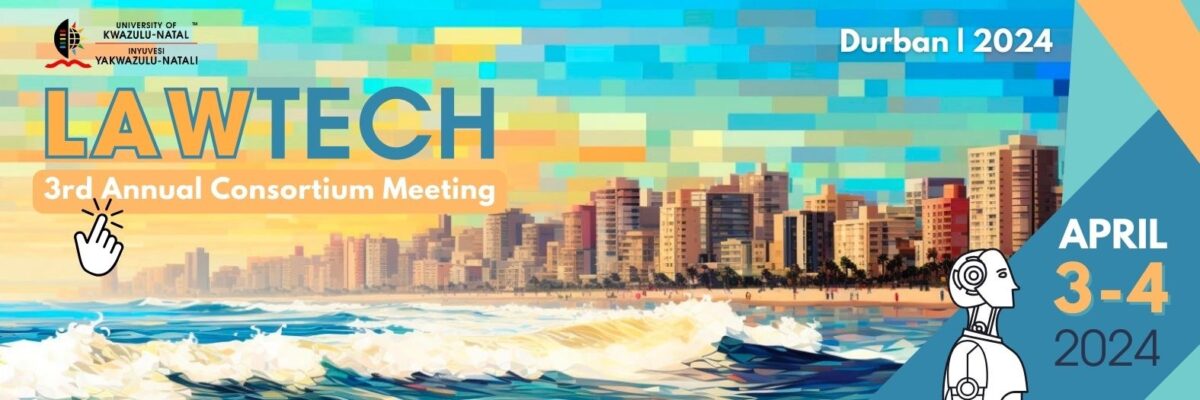April 3-4, 2024
LawTech Consortium – 3rd Meeting, April 3-4 2024, University of Kwazulu-Natal, Durban

***
Intellectual Property and Open Science in European Union Research and Innovation Policies. What Role for the Public Sector and Universities?
Roberto Caso
Third Annual LAWTECH Consortium, UKZN – University of KwaZulu-Natal, Durban, South Africa, Version 2.0 – 27.03.2024
Abstract
The complex relationship between Intellectual Property (IP) and Open Science (OS) deserves to be investigated with reference to one of the most important centers of Research and Innovation (R&I) production: the university.
In a stylized model of R&I in the context of a free-market capitalist system, there are, upstream, the public sector and universities that create basic research following the principles of OS and, downstream, a competitive market that carries out applied research, produces and markets new technologies using Intellectual Property Rights (IPRs). The competitiveness of the market drives down the price of technology, so that access to innovation is guaranteed through contracts or redistributive mechanisms (e.g. public subsidies).
However, this model hides the friction between IP and OS.
A first example of friction between IP and OS relates to scientific publications. Let us assume that the law of Country X states that when a university researcher publishes a scientific article, she is the sole owner of the copyright. In other words, the university where she belongs cannot claim any rights to the scientific article. A dilemma arises for the researcher.
Option 1. Through a copyright transfer agreement, the researcher assigns the economic copyright to a big publisher (a large enterprise in scientific publishing and data analysis) in country Y that publishes in a digital journal contained in a closed-access online database. Anyone wishing to read, reproduce or communicate the article to the public must enter into a license agreement with the publisher to use the database by paying a price for the licensed uses. The use of the article is subject to the publisher’s copyright. In addition, the prohibitions imposed by the license agreement are supported by Technological Protection Measures (TPMs). The article file is in databases on a server located in country W. Without a login and password, it is not even possible to access the scientific article online. This option has broader and international implications. The university in country X transfers data to countries Y and W. The researcher in a developing country Z cannot access the scientific article because neither she nor the university she belongs can afford to pay the price for access to the database. More than this. The publisher (data analysis company) can apply the logic of surveillance capitalism to the use of the database by monitoring the behavior of those who access and use the contents of the database. There is not only a transfer of money and scientific data but also personal data from the person using the database to the publisher (data analysis company).
Option 2. The researcher publishes the article in the online open access (OA) journal published by her university. The researcher applies an open copyright license such as a Creative Commons Attribution – Share Alike license to the article. In this scenario, the digital file of the article is an OA archive located on servers owned by the university. Everyone who accesses the archive online has the right to download a copy of the article, reproduce it, distribute it. In addition, everyone has the right to derive a derivative work – for example, a translation into a different language – and publish it on another OA repository under the same Creative Commons license. Anyone in the world can benefit from the scientific publication. The university does not engage in mass surveillance and respects the privacy of authors and readers.
A second example concerns university patents. Think about patents in the biomedical field and in particular patents on vaccines, which were the subject of much debate during the Covid-19 pandemic. Imagine that a group of researchers at the university of Country X discover a new vaccine. Assume also that the law of Country X provides that ownership of the invention does not lie with the researchers but with the university to which the research group belongs. The university faces a dilemma:
Option A. The university patents the invention and transfers the IPR (the invention patent), by way of assignment, to a multinational pharmaceutical company (big pharma) with a parent company in Country Y. The multinational adds its own secret technology to the patented technology. While the patent is public and can be studied, the secret technology cannot be studied.
Option B. The university renounces the patent and publishes the results of vaccine research in open access on the web, destroying one of the patentability requirements: the novelty of the invention. Anyone in the world can replicate the research and produce the vaccine, but no one can patent it. The two cases are extreme simplifications of reality. But they are enough to trigger the reasoning.
In the two cases illustrated, options 1) and A) lead to the privatization of knowledge generated in the university. The power to determine how knowledge can circulate and be used shifts from the university to big companies with market power (the ‘big’ associated with publishers and pharma implies monopoly power). Options 2) and B) lead instead to knowledge sharing through OS practices. What drives states (public sector), non-profit organizations, universities and researchers to choose between privatization and sharing?
Several considerations influence the choice. Among the many factors, the following should be considered for the purposes of this paper: the ethos of science (social norms), technology, economic variables (e.g. the public or private nature of funding, the prospects of profiting from the exclusive control of knowledge, etc.), legal norms (in particular, those relating to intellectual property), the research assessment system, and geopolitics.
This paper focuses on the European Union (EU) research and innovation policies. To understand the merits and shortcomings of EU policies, a good investigation methodology is needed. The one used in the following reasoning is inspired not only by the usual methods and tools of comparative law but also by a new movement of ideas that goes by the name of ‘Law and Political Economy’ and sees among its promoters Amy Kapczynski (Yale University). The premise from which the movement starts is that politics and economics cannot be separated and that both are closely intertwined with law. In an era marked by climate change, huge and growing inequalities as well as wars that threaten democratic systems, it is necessary to investigate phenomena – in this case, the relationship between IP and OS – with the three dimensions of politics, economics and law in mind.
In EU policies, on the one hand, actions promoting universities’ OS are growing, and on the other hand, IPRs are being extended and their use and transfer to private individuals is being encouraged in academic institutions themselves.
This dual approach in policies regulating the relationship between IP and OS is a contradiction if universities are considered to play a relevant, autonomous and market-independent role. In other words, there is a fundamental contradiction if one keeps the public and non-profit sector separate from the private and commercial one. On the contrary, if one sees the university and its OS practices as instrumental to commercial interests, the contradiction vanishes: the privatization of knowledge is the physiology of academic capitalism, and the boundary between public and private, between university and business, blurs.
In a research and innovation ecosystem dominated by the intellectual monopoly capitalism, the promotion of OS runs the risk of being, at best, ineffective or limitedly effective and, at worst, a tool to strengthen the monopolies themselves.
The ideal and stylized model of technological innovation of a capitalist system with the OS of the university upstream and the market for technological innovation based on IPRs downstream is far away from the current reality for several reasons.
I) The blurred distinction between university and business. Universities are no longer clearly distinct entities from commercial companies, because they are organized according to business logic. This is a legal issue (institutional architecture and evaluation rules), but also a matter of ethics (norms of science) and mentality.
II) The erosion of OS. Academic practices and the ethos of OS have been progressively eroded by researchers’ increasing use of IP. This extensive use of exclusive rights is the result of not only economic but also research assessment incentives. The use of intellectual property triggers irreconcilable conflicts between the interest in pursuing the advancement of knowledge and the interest in profit.
III) The domination of intellectual monopolies. The big intellectual monopolies do not necessarily have to wait for the public sector and universities to decide to transfer knowledge, because they are able to appropriate it. One thinks of the growing domination of big tech in the field of academic infrastructure, a domination that is expressed not only in the appropriation of scientific research data (now also aimed at the training of artificial intelligence), but also of scientists’ personal data. Think also of the cultural capture through the rich financing of projects whose results are geared to the interests of private financiers (the intellectual monopolies).
IV) Geopolitics interferes in the dynamics of closing and opening innovation. In times of wars and increasing international tensions, the enclosure of scientific knowledge is used as weapon.
Individual choices and the responsibilities that accompany them remain. The examples given allude to the space of freedom that remains in the field for individual researchers and universities. In other words, opting for sharing instead of privatization remains a possible but sometime difficult choice. OS is an integral part of academic freedom and cosmopolitan dialogue that helps cooperation and peace. In short, it is a set of values and ideals outside condemned to marginality. Unless the new generations inside and outside Europe can build a better future than the present we have handed over to them.
Essential references
COUNCIL OF THE EUROPEAN UNION, Council Recommendation (EU) 2022/2415 of 2 December 2022 on the guiding principles for knowledge valorisation, OJEU L 317/141, 9.12.2022
EUROPEAN COMMISSION, DIRECTORATE-GENERAL FOR RESEARCH AND INNOVATION EUROPEAN RESEARCH, Communication form the Commission to the European Parliament, the Council, the European Economic and Social Committee and the Committee of the Regions, Making the most of the EU’s innovative potential, An intellectual property action plan to support the EU’s recovery and resilience, Brussels, 25.11.2020, COM(2020) 760 final
EUROPEAN COMMISSION, DIRECTORATE-GENERAL FOR RESEARCH AND INNOVATION EUROPEAN RESEARCH, European Research Area Policy Agenda – Overview of actions for the period 2022-2024, Brussels, Manuscript completed in November 2021, 1st edition, B-1049
C. GEIGER, B.J. JÜTTE, Conceptualizing a ‘Right to Research’ and its Implications for Copyright Law: An International and European Perspective (April 10, 2023). Forthcoming, 38(1) American University International Law Review (2023), 1-86, available at SSRN: <https://ssrn.com/abstract=4414085>
E.R. GOLD, The fall of the innovation empire and its possible rise through open science, in Research Policy 50 (2021) 104226
ISTITUTO DI RICERCHE FARMACOLOGICHE MARIO NEGRI IRCCS, Why do we not patent our findings?, <https://www.marionegri.it/eng/not-patenting>.
A. KAPCZYNSKI ET AL., New Law and Political Economy Project Launched, 29.04.2019 <https://law.yale.edu/yls-today/news/new-law-and-political-economy-project-launched>
MCGILL – NEURO, Open Science Principles, <https://www.mcgill.ca/neuro/open-science/open- science-principles>
D. TRAFICONTE, Property and Power on the Endless Frontier (August 9, 2021), available at SSRN: <https://ssrn.com/abstract=3901914> or <http://dx.doi.org/10.2139/ssrn.3901914>
U. PAGANO, The Crisis of Intellectual Monopoly Capitalism (November 13, 2014), Cambridge Journal of Economics V. 38 pp. 1409-1431, available at SSRN: <https://ssrn.com/abstract=2537972>
UNITED NATIONS, COMMITTEE ON ECONOMIC, SOCIAL AND CULTURAL RIGHTS (CESCR), General comment No. 25 (2020) on science and economic, social and cultural rights (article 15 (1) (b), (2), (3) and (4) of the International Covenant on Economic, Social and Cultural Rights), 30.04.2020
P.K. YU, The Complex Interplay Between Intellectual Property and the Right to Science (March 3, 2024). Boston University Law Review, Vol. 104, Forthcoming, Texas A&M University School of Law Legal Studies Research Paper Forthcoming, Available at SSRN: <https://ssrn.com/abstract=4746394>, <http://dx.doi.org/10.2139/ssrn.4746394>
***
This text is licensed under CC BY-SA 4.0 license

